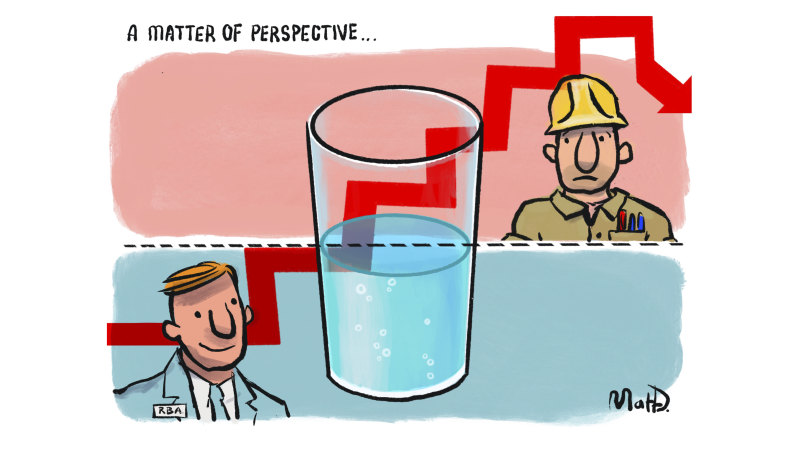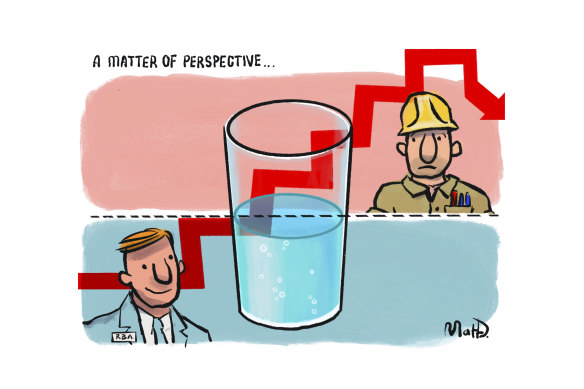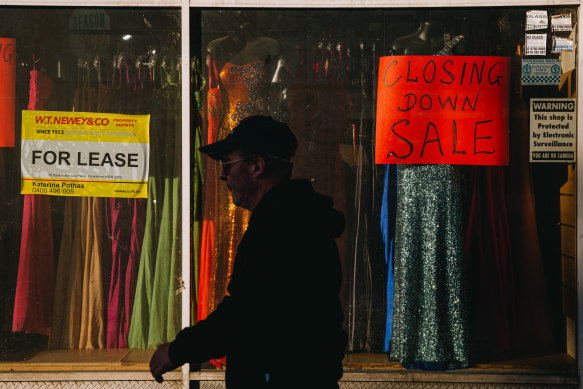
RBA’s double whammy: Hit wages and raise interest rates
August 17, 2023Save articles for later
Add articles to your saved list and come back to them any time.
If the sharp increase in interest rates we’ve seen leads to a recession, it will be the recession we didn’t have to have. The judgement of hindsight will be that the Reserve Bank’s mistake was to worry about wage growth being too high, when it should have worried about it being too low.
The underrated economic news this week was the Australian Bureau of Statistics’ announcement that its wage price index grew by 0.8 per cent over the three months to the end of June, and by 3.6 per cent over the year to June.
The Reserve Bank’s anti-inflation strategy is working and the return to low inflation may happen a little earlier.Credit: Matt Davidson
This was the third quarter in a row that wages had risen by 0.8 per cent, but annual growth was down a fraction from 3.7 per cent over the year to March. It was a slowdown the Reserve hadn’t expected.
So, the obvious question arises: is it good news or bad? Short answer: depends on your perspective. Long answer: keep reading.
The Reserve would have regarded the modest fall as good news because its focus is on getting the rate of inflation down to its 2 to 3 per cent target range as soon as reasonably possible. The slight lowering in wage growth will help in two ways.
First, it means a slightly smaller increase in businesses’ wage costs, which should mean they increase their prices by a little less.
Second, the slight fall in wage growth slightly increases the squeeze on households’ incomes, making it a little harder for them to keep spending as much on goods and services. The less the demand for their products, the less the scope for businesses to raise their prices.
It’s hardly a big change, obviously, but it’s in the right direction. It’s a sign the Reserve’s anti-inflation strategy is working and that the return to low inflation may happen a little earlier.
But what if you’re just a worker – is it good news or bad, from your perspective? Well, Treasurer Jim Chalmers would like to remind you that wage growth of 3.7 or 3.6 per cent is the highest we’ve had since mid-2012.
Not bad, eh? Trust Labor to get your wages up.
I trust you’re sufficiently economically literate to see through that one. Back then, the annual rate of inflation was about 2 per cent, whereas in June quarter this year it was 6 per cent – not long down from a peak of 7.8 per cent.
So wage growth of 3.6 per cent is hardly anything to boast about. Wages might be up, but prices are up by a lot more. Take account of inflation, and “real” wages actually fell by 2.4 per cent over the year to June.
Over the 11 years to June, consumer prices rose by 33 per cent, whereas the wage price index rose by 29 per cent. If you’re a worker, that’s hardly something to celebrate.
Why do ordinary people put up with the capitalist system, in which big business people are revered like Greek gods, permitted to lecture us on our many failings, and allowed to pay themselves maybe 40 times what an ordinary worker gets?
The jury is still out on whether Australia can avoid falling into recession.Credit: Dion Georgopoulos
Because the punters get their cut. Because enough of the benefits trickle down to ordinary workers to give them a steadily improving standard of living. Because wages almost always rise a bit faster than prices do.
This is the “social contract” the rich and powerful have made with the rest of us for letting them call the shots. But for the past decade or more we’ve got nothing from the deal. Indeed, our standard of living has slipped back.
Don’t worry, say Chalmers and his boss Anthony Albanese, it won’t be more than a year or three before inflation’s down lower than wage growth and real wages are back to growing a bit each year.
Yeah, maybe. It’s certainly what should happen, it happened in the past, so maybe it will happen again. But one thing we can be sure of: we’re unlikely ever to catch up from the losing decade.
Throughout the Reserve’s response to the post-pandemic period, it’s had next to nothing to say about the abandon with which businesses have been whacking up their prices, while always on about the need for wage growth to be restrained.
It’s tempting to think that, in the mind of the Reserve, the only function wages serve is to help it achieve its inflation target. When inflation’s below the target, the Reserve wants bigger pay rises to get inflation up. When inflation’s below the target, it wants lower pay rises to get inflation down.
The truth is, the Reserve’s been mesmerised by the threat that roaring wages would pose to lower inflation. Its limited understanding of the forces bearing on wages is revealed by its persistent over-forecasting of how fast they will grow.
Once the unemployment rate began falling towards 3.5 per cent and the jobs market became so tight – with job vacancies far exceeding the number of unemployed workers – it has lived in fear of surging wages as employers bid up wages in their frantic efforts to hang on to or recruit skilled workers.
It just hasn’t happened. As we’ve seen, wages haven’t risen enough merely to keep up with prices, much less soar above them.
The Reserve has worried unceasingly that the price surge would adversely affect people’s expectations about inflation, leading to a wage-price spiral that would keep inflation high forever. This is why it’s kept raising interest rates and been rushing to see inflation fall back.
Again, it just hasn’t happened.
Normally, when inflation’s been surging and the Reserve has been raising interest rates to slow down our spending, real wages have been growing strongly. But not this time. This time, falling real wages have greatly contributed to the squeeze on households and their spending.
That’s why, if this week’s falling employment and rising unemployment continue to the point of recession, people will realise the Reserve’s mistake was to worry about wage growth being too high, when it should have worried about it being too low.
Ross Gittins is the economics editor of The Sydney Morning Herald.
Ross Gittins unpacks the economy in an exclusive subscriber-only newsletter every Tuesday evening. Sign up to receive it here.
Most Viewed in Business
From our partners
Source: Read Full Article




